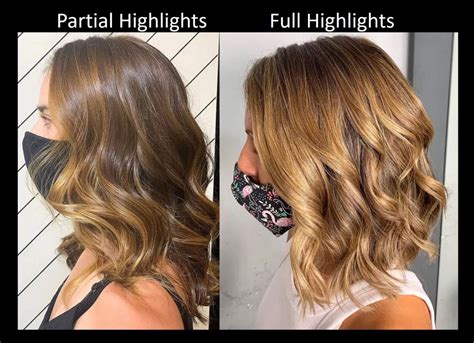Whether you’re seeking a subtle refresh or a dramatic transformation, highlights are a versatile hair coloring technique that can enhance your look. But when it comes to choosing between partial and full highlights, which option is right for you? Here’s a comprehensive guide to help you make an informed decision.

What’s the Difference?
Partial Highlights (25% – 50% Coverage)
Partial highlights involve adding lighter streaks to specific sections of your hair, typically around the face, crown, and part. This technique creates a natural-looking, sun-kissed effect without significantly altering your overall hair color.
Full Highlights (50% – 100% Coverage)
Full highlights, as the name suggests, cover a larger portion of your hair (at least 50%). They create a more dramatic and noticeable color change, making them ideal for those looking for a bolder transformation.
Which Type Is Right for You?
Consider these factors when choosing between partial and full highlights:
- Desired Effect: Partial highlights offer a subtle enhancement, while full highlights deliver a more noticeable change.
- Hair History: If your hair has been previously colored or damaged, partial highlights may be a gentler option.
- Maintenance: Full highlights require more frequent touch-ups to maintain their vibrancy, while partial highlights can last longer.
- Budget: Partial highlights are typically less expensive than full highlights due to the reduced amount of hair being treated.
Pros and Cons of Partial Highlights
Pros:
- Natural-looking, sun-kissed effect
- Less damaging to hair
- Lower maintenance
- More affordable
Cons:
- Less dramatic color change
- Not suitable for all hair colors (e.g., dark brown)
Pros and Cons of Full Highlights
Pros:
- Bold, noticeable color change
- Can brighten up dark hair
- Can correct previous hair color mistakes
Cons:
- More damaging to hair
- Requires frequent touch-ups
- More expensive
- Not suitable for all hair types (e.g., fine, damaged)
Helpful Tables
Table 1: Comparison of Partial and Full Highlights
| Feature | Partial Highlights | Full Highlights |
|---|---|---|
| Coverage | 25% – 50% | 50% – 100% |
| Effect | Natural-looking | Dramatic |
| Maintenance | Lower | Higher |
| Cost | More affordable | More expensive |
Table 2: Hair Color Suitability
| Hair Color | Partial Highlights | Full Highlights |
|---|---|---|
| Blonde | Ideal | Can wash out color |
| Brunette | Good option for subtle enhancement | Can create desirable contrast |
| Black | Not recommended | Can be difficult to achieve |
Table 3: Hair Damage Potential
| Hair Health | Partial Highlights | Full Highlights |
|---|---|---|
| Healthy | Lower risk | Moderate risk |
| Damaged | Not recommended | High risk |
Table 4: Maintenance Frequency
| Hair Growth Rate | Partial Highlights | Full Highlights |
|---|---|---|
| Slow (1/4 inch per month) | 3-4 months | 2-3 months |
| Medium (1/2 inch per month) | 2-3 months | 1-2 months |
| Fast (3/4 inch per month) | 1-2 months | Less than 1 month |
Innovative Applications
Thought-Provoking Ideas:
- Intensify: Use partial highlights to accentuate natural curls or waves.
- Contour: Place highlights around the face to create a flattering shape.
- Customize: Combine partial and full highlights for a personalized look.
By understanding the differences between partial and full highlights, you can choose the technique that best suits your desired effect, hair history, and lifestyle. Whether you crave a subtle touch of color or a head-turning transformation, highlights can help you achieve the perfect hair makeover.
